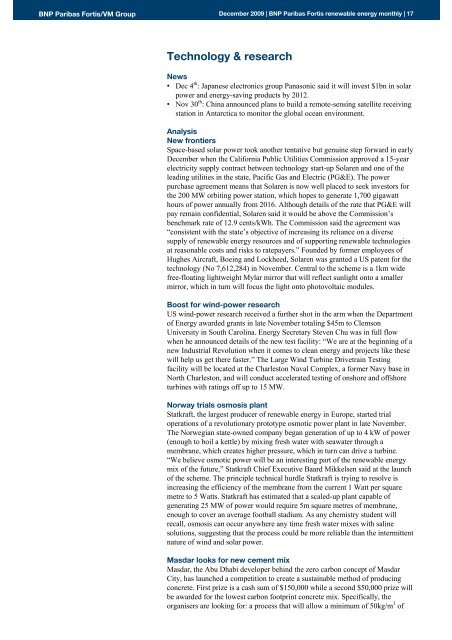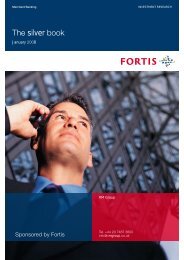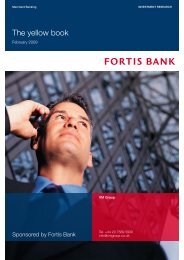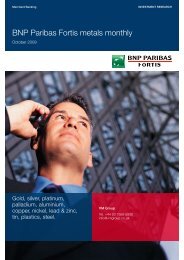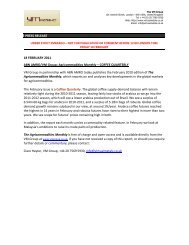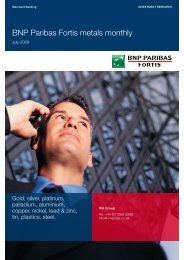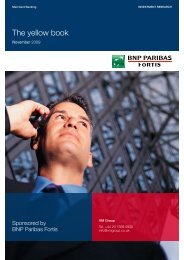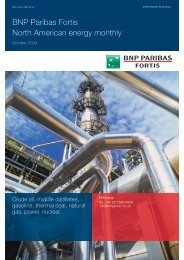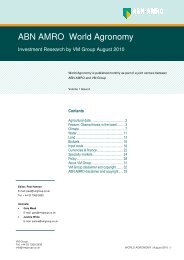BNP Paribas Fortis renewable energy monthly - Virtual Metals
BNP Paribas Fortis renewable energy monthly - Virtual Metals
BNP Paribas Fortis renewable energy monthly - Virtual Metals
You also want an ePaper? Increase the reach of your titles
YUMPU automatically turns print PDFs into web optimized ePapers that Google loves.
<strong>BNP</strong> <strong>Paribas</strong> <strong>Fortis</strong>/VM Group December 2009 | <strong>BNP</strong> <strong>Paribas</strong> <strong>Fortis</strong> <strong>renewable</strong> <strong>energy</strong> <strong>monthly</strong> | 17<br />
Technology & research<br />
News<br />
• Dec 4 th : Japanese electronics group Panasonic said it will invest $1bn in solar<br />
power and <strong>energy</strong>-saving products by 2012.<br />
• Nov 30 th : China announced plans to build a remote-sensing satellite receiving<br />
station in Antarctica to monitor the global ocean environment.<br />
Analysis<br />
New frontiers<br />
Space-based solar power took another tentative but genuine step forward in early<br />
December when the California Public Utilities Commission approved a 15-year<br />
electricity supply contract between technology start-up Solaren and one of the<br />
leading utilities in the state, Pacific Gas and Electric (PG&E). The power<br />
purchase agreement means that Solaren is now well placed to seek investors for<br />
the 200 MW orbiting power station, which hopes to generate 1,700 gigawatt<br />
hours of power annually from 2016. Although details of the rate that PG&E will<br />
pay remain confidential, Solaren said it would be above the Commission’s<br />
benchmark rate of 12.9 cents/kWh. The Commission said the agreement was<br />
“consistent with the state’s objective of increasing its reliance on a diverse<br />
supply of <strong>renewable</strong> <strong>energy</strong> resources and of supporting <strong>renewable</strong> technologies<br />
at reasonable costs and risks to ratepayers.” Founded by former employees of<br />
Hughes Aircraft, Boeing and Lockheed, Solaren was granted a US patent for the<br />
technology (No 7,612,284) in November. Central to the scheme is a 1km wide<br />
free-floating lightweight Mylar mirror that will reflect sunlight onto a smaller<br />
mirror, which in turn will focus the light onto photovoltaic modules.<br />
Boost for wind-power research<br />
US wind-power research received a further shot in the arm when the Department<br />
of Energy awarded grants in late November totaling $45m to Clemson<br />
University in South Carolina. Energy Secretary Steven Chu was in full flow<br />
when he announced details of the new test facility: “We are at the beginning of a<br />
new Industrial Revolution when it comes to clean <strong>energy</strong> and projects like these<br />
will help us get there faster.” The Large Wind Turbine Drivetrain Testing<br />
facility will be located at the Charleston Naval Complex, a former Navy base in<br />
North Charleston, and will conduct accelerated testing of onshore and offshore<br />
turbines with ratings off up to 15 MW.<br />
Norway trials osmosis plant<br />
Statkraft, the largest producer of <strong>renewable</strong> <strong>energy</strong> in Europe, started trial<br />
operations of a revolutionary prototype osmotic power plant in late November.<br />
The Norwegian state-owned company began generation of up to 4 kW of power<br />
(enough to boil a kettle) by mixing fresh water with seawater through a<br />
membrane, which creates higher pressure, which in turn can drive a turbine.<br />
“We believe osmotic power will be an interesting part of the <strong>renewable</strong> <strong>energy</strong><br />
mix of the future,” Statkraft Chief Executive Baard Mikkelsen said at the launch<br />
of the scheme. The principle technical hurdle Statkraft is trying to resolve is<br />
increasing the efficiency of the membrane from the current 1 Watt per square<br />
metre to 5 Watts. Statkraft has estimated that a scaled-up plant capable of<br />
generating 25 MW of power would require 5m square metres of membrane,<br />
enough to cover an average football stadium. As any chemistry student will<br />
recall, osmosis can occur anywhere any time fresh water mixes with saline<br />
solutions, suggesting that the process could be more reliable than the intermittent<br />
nature of wind and solar power.<br />
Masdar looks for new cement mix<br />
Masdar, the Abu Dhabi developer behind the zero carbon concept of Masdar<br />
City, has launched a competition to create a sustainable method of producing<br />
concrete. First prize is a cash sum of $150,000 while a second $50,000 prize will<br />
be awarded for the lowest carbon footprint concrete mix. Specifically, the<br />
organisers are looking for: a process that will allow a minimum of 50kg/m 3 of


